Management and Operations: Leadership Roles and Theories Analysis
VerifiedAdded on 2020/10/05
|20
|5389
|60
Report
AI Summary
This report delves into the critical distinctions between leadership and management within the context of operational management. It begins by defining and contrasting the roles and responsibilities of leaders and managers, highlighting their distinct functions in strategic planning, team coordination, and resource allocation. The report then explores how these roles are applied in various situational contexts, such as employee turnover and conflict resolution, using examples from companies like Sainsbury Plc, Tesco Plc, and Marks and Spencer. Furthermore, it examines different leadership theories, including contingency management theory, and their practical application. Key approaches to operations management are discussed, emphasizing the importance of operations management in achieving business objectives and the factors influencing operational decision-making by leaders and managers. The analysis covers hard and soft skills, and the impact of leadership styles on productivity and conflict resolution, providing a comprehensive overview of effective management practices.
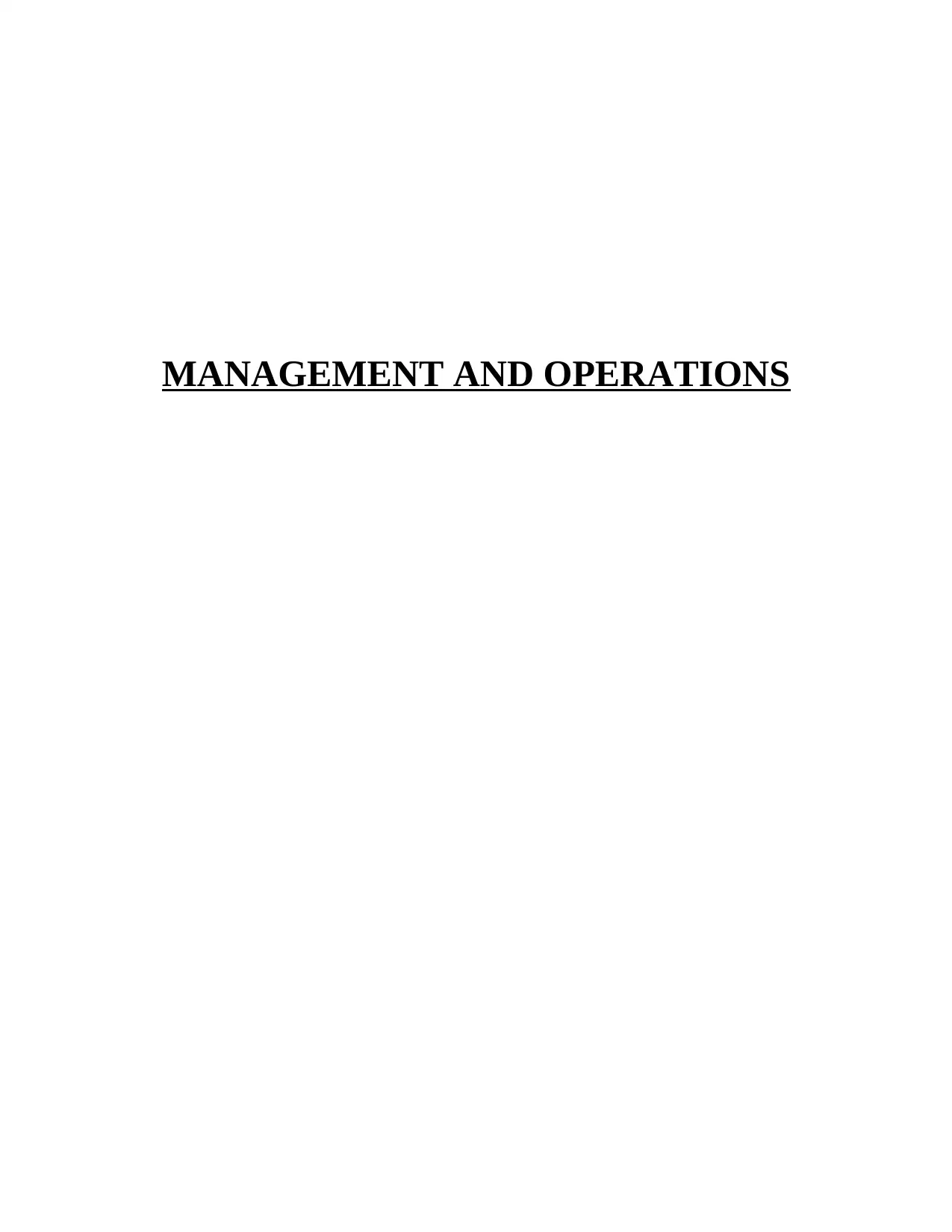
MANAGEMENT AND OPERATIONS
Paraphrase This Document
Need a fresh take? Get an instant paraphrase of this document with our AI Paraphraser
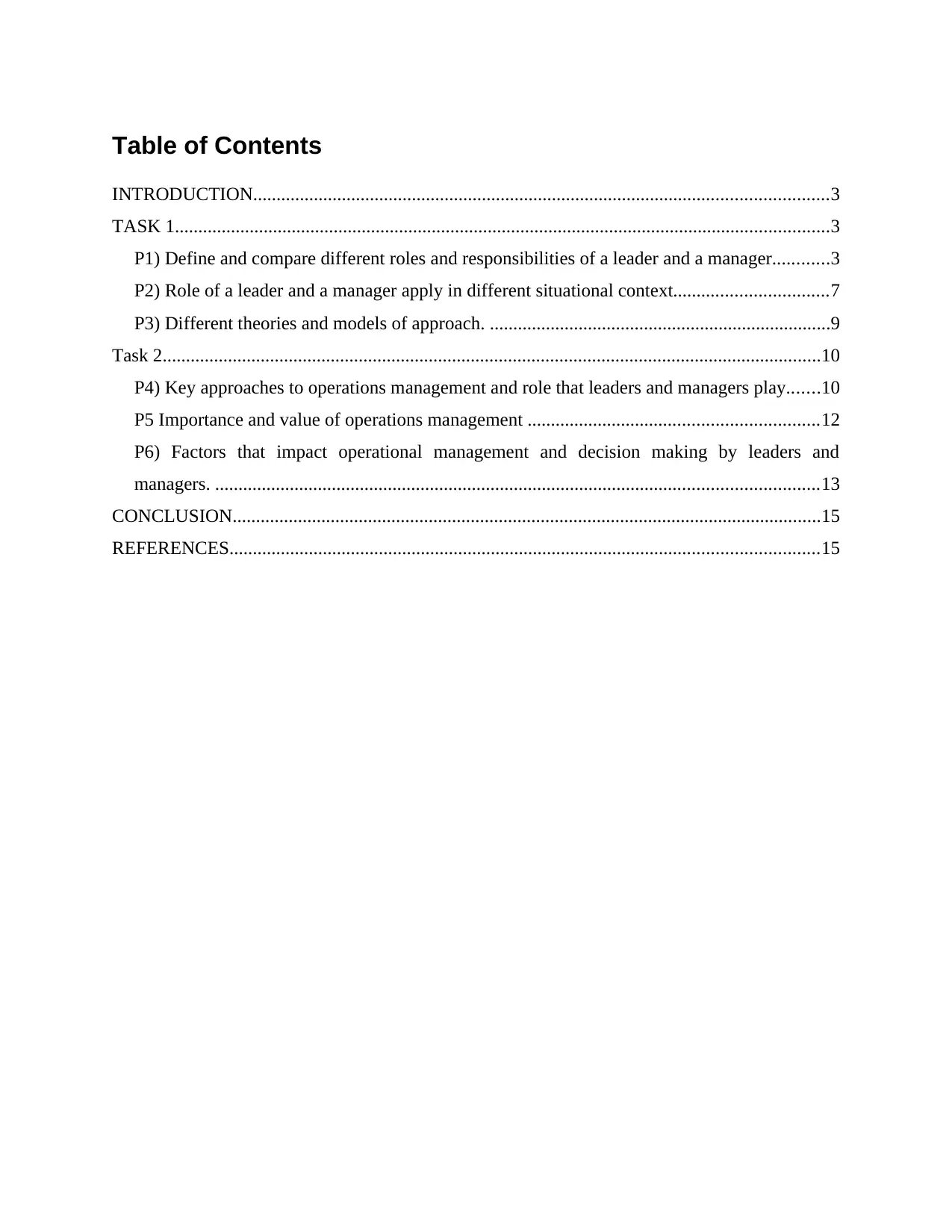
Table of Contents
INTRODUCTION...........................................................................................................................3
TASK 1............................................................................................................................................3
P1) Define and compare different roles and responsibilities of a leader and a manager............3
P2) Role of a leader and a manager apply in different situational context.................................7
P3) Different theories and models of approach. .........................................................................9
Task 2.............................................................................................................................................10
P4) Key approaches to operations management and role that leaders and managers play.......10
P5 Importance and value of operations management ..............................................................12
P6) Factors that impact operational management and decision making by leaders and
managers. .................................................................................................................................13
CONCLUSION..............................................................................................................................15
REFERENCES..............................................................................................................................15
INTRODUCTION...........................................................................................................................3
TASK 1............................................................................................................................................3
P1) Define and compare different roles and responsibilities of a leader and a manager............3
P2) Role of a leader and a manager apply in different situational context.................................7
P3) Different theories and models of approach. .........................................................................9
Task 2.............................................................................................................................................10
P4) Key approaches to operations management and role that leaders and managers play.......10
P5 Importance and value of operations management ..............................................................12
P6) Factors that impact operational management and decision making by leaders and
managers. .................................................................................................................................13
CONCLUSION..............................................................................................................................15
REFERENCES..............................................................................................................................15
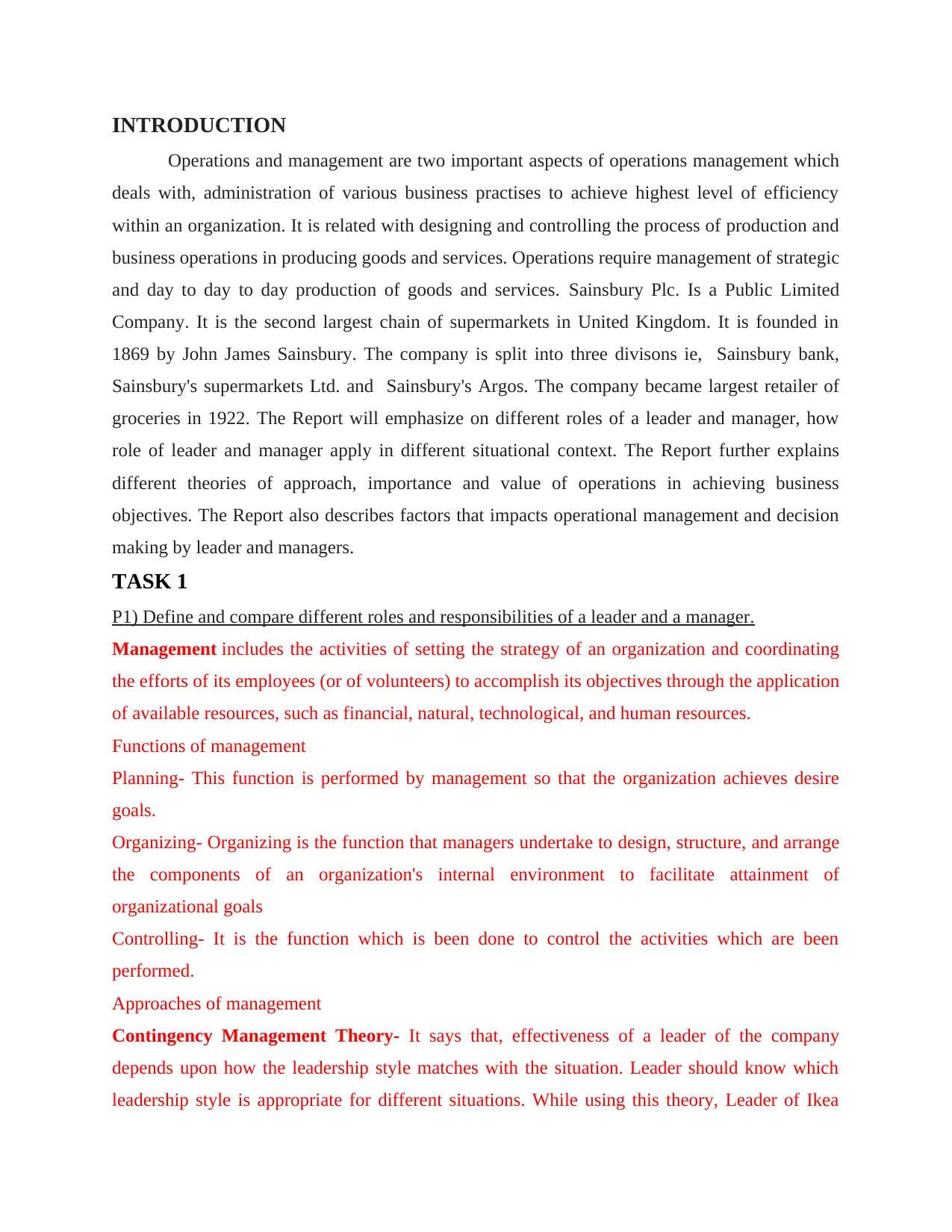
INTRODUCTION
Operations and management are two important aspects of operations management which
deals with, administration of various business practises to achieve highest level of efficiency
within an organization. It is related with designing and controlling the process of production and
business operations in producing goods and services. Operations require management of strategic
and day to day to day production of goods and services. Sainsbury Plc. Is a Public Limited
Company. It is the second largest chain of supermarkets in United Kingdom. It is founded in
1869 by John James Sainsbury. The company is split into three divisons ie, Sainsbury bank,
Sainsbury's supermarkets Ltd. and Sainsbury's Argos. The company became largest retailer of
groceries in 1922. The Report will emphasize on different roles of a leader and manager, how
role of leader and manager apply in different situational context. The Report further explains
different theories of approach, importance and value of operations in achieving business
objectives. The Report also describes factors that impacts operational management and decision
making by leader and managers.
TASK 1
P1) Define and compare different roles and responsibilities of a leader and a manager.
Management includes the activities of setting the strategy of an organization and coordinating
the efforts of its employees (or of volunteers) to accomplish its objectives through the application
of available resources, such as financial, natural, technological, and human resources.
Functions of management
Planning- This function is performed by management so that the organization achieves desire
goals.
Organizing- Organizing is the function that managers undertake to design, structure, and arrange
the components of an organization's internal environment to facilitate attainment of
organizational goals
Controlling- It is the function which is been done to control the activities which are been
performed.
Approaches of management
Contingency Management Theory- It says that, effectiveness of a leader of the company
depends upon how the leadership style matches with the situation. Leader should know which
leadership style is appropriate for different situations. While using this theory, Leader of Ikea
Operations and management are two important aspects of operations management which
deals with, administration of various business practises to achieve highest level of efficiency
within an organization. It is related with designing and controlling the process of production and
business operations in producing goods and services. Operations require management of strategic
and day to day to day production of goods and services. Sainsbury Plc. Is a Public Limited
Company. It is the second largest chain of supermarkets in United Kingdom. It is founded in
1869 by John James Sainsbury. The company is split into three divisons ie, Sainsbury bank,
Sainsbury's supermarkets Ltd. and Sainsbury's Argos. The company became largest retailer of
groceries in 1922. The Report will emphasize on different roles of a leader and manager, how
role of leader and manager apply in different situational context. The Report further explains
different theories of approach, importance and value of operations in achieving business
objectives. The Report also describes factors that impacts operational management and decision
making by leader and managers.
TASK 1
P1) Define and compare different roles and responsibilities of a leader and a manager.
Management includes the activities of setting the strategy of an organization and coordinating
the efforts of its employees (or of volunteers) to accomplish its objectives through the application
of available resources, such as financial, natural, technological, and human resources.
Functions of management
Planning- This function is performed by management so that the organization achieves desire
goals.
Organizing- Organizing is the function that managers undertake to design, structure, and arrange
the components of an organization's internal environment to facilitate attainment of
organizational goals
Controlling- It is the function which is been done to control the activities which are been
performed.
Approaches of management
Contingency Management Theory- It says that, effectiveness of a leader of the company
depends upon how the leadership style matches with the situation. Leader should know which
leadership style is appropriate for different situations. While using this theory, Leader of Ikea
⊘ This is a preview!⊘
Do you want full access?
Subscribe today to unlock all pages.

Trusted by 1+ million students worldwide
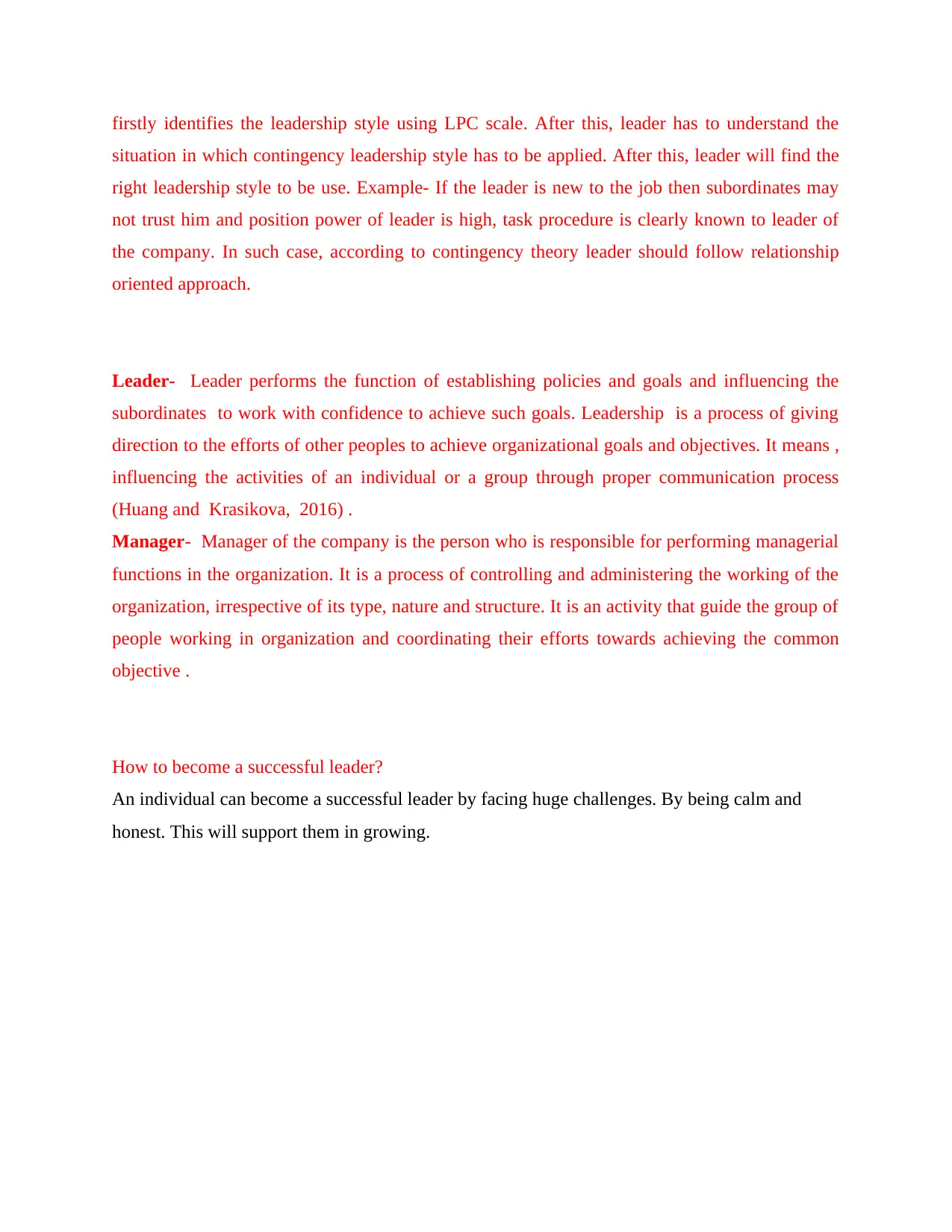
firstly identifies the leadership style using LPC scale. After this, leader has to understand the
situation in which contingency leadership style has to be applied. After this, leader will find the
right leadership style to be use. Example- If the leader is new to the job then subordinates may
not trust him and position power of leader is high, task procedure is clearly known to leader of
the company. In such case, according to contingency theory leader should follow relationship
oriented approach.
Leader- Leader performs the function of establishing policies and goals and influencing the
subordinates to work with confidence to achieve such goals. Leadership is a process of giving
direction to the efforts of other peoples to achieve organizational goals and objectives. It means ,
influencing the activities of an individual or a group through proper communication process
(Huang and Krasikova, 2016) .
Manager- Manager of the company is the person who is responsible for performing managerial
functions in the organization. It is a process of controlling and administering the working of the
organization, irrespective of its type, nature and structure. It is an activity that guide the group of
people working in organization and coordinating their efforts towards achieving the common
objective .
How to become a successful leader?
An individual can become a successful leader by facing huge challenges. By being calm and
honest. This will support them in growing.
situation in which contingency leadership style has to be applied. After this, leader will find the
right leadership style to be use. Example- If the leader is new to the job then subordinates may
not trust him and position power of leader is high, task procedure is clearly known to leader of
the company. In such case, according to contingency theory leader should follow relationship
oriented approach.
Leader- Leader performs the function of establishing policies and goals and influencing the
subordinates to work with confidence to achieve such goals. Leadership is a process of giving
direction to the efforts of other peoples to achieve organizational goals and objectives. It means ,
influencing the activities of an individual or a group through proper communication process
(Huang and Krasikova, 2016) .
Manager- Manager of the company is the person who is responsible for performing managerial
functions in the organization. It is a process of controlling and administering the working of the
organization, irrespective of its type, nature and structure. It is an activity that guide the group of
people working in organization and coordinating their efforts towards achieving the common
objective .
How to become a successful leader?
An individual can become a successful leader by facing huge challenges. By being calm and
honest. This will support them in growing.
Paraphrase This Document
Need a fresh take? Get an instant paraphrase of this document with our AI Paraphraser
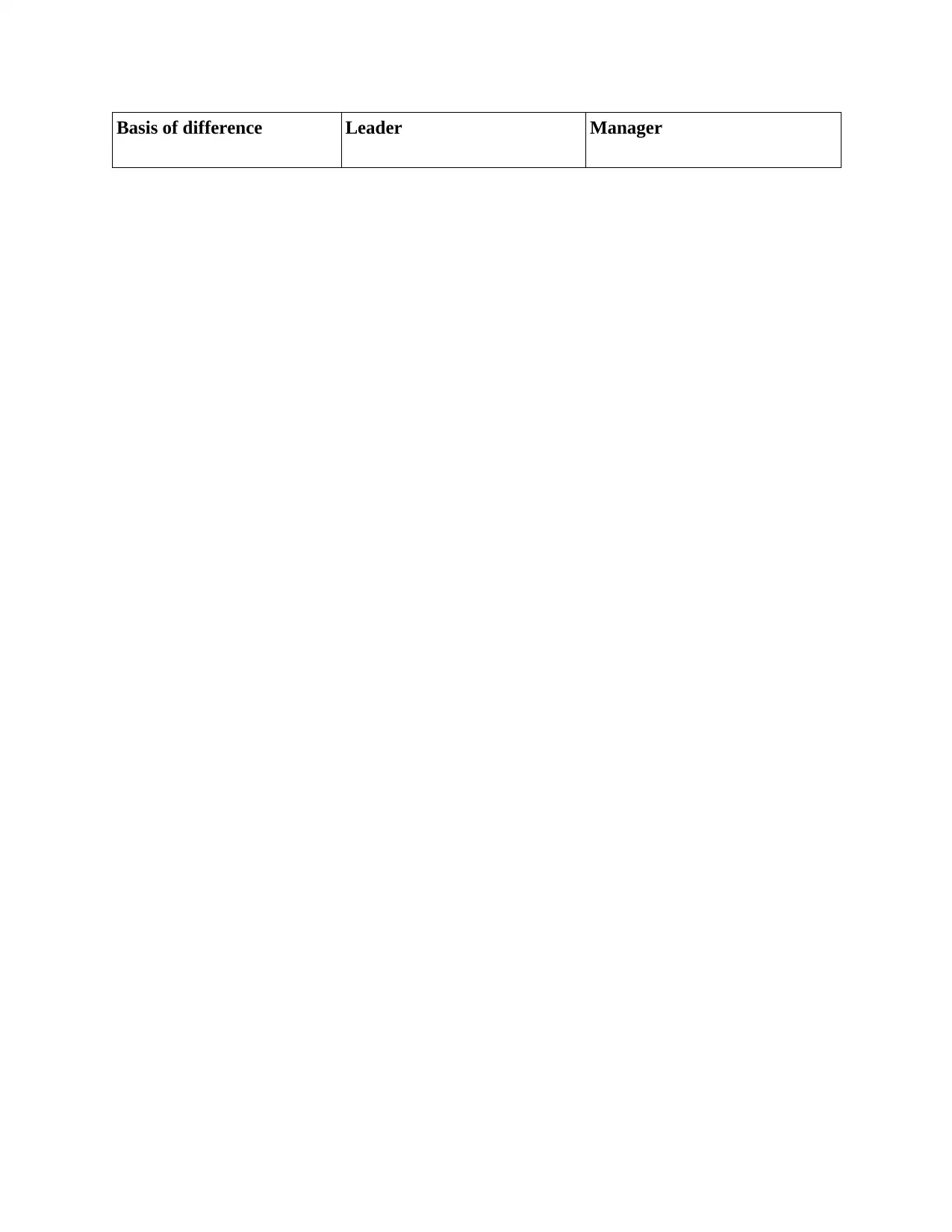
Basis of difference Leader Manager
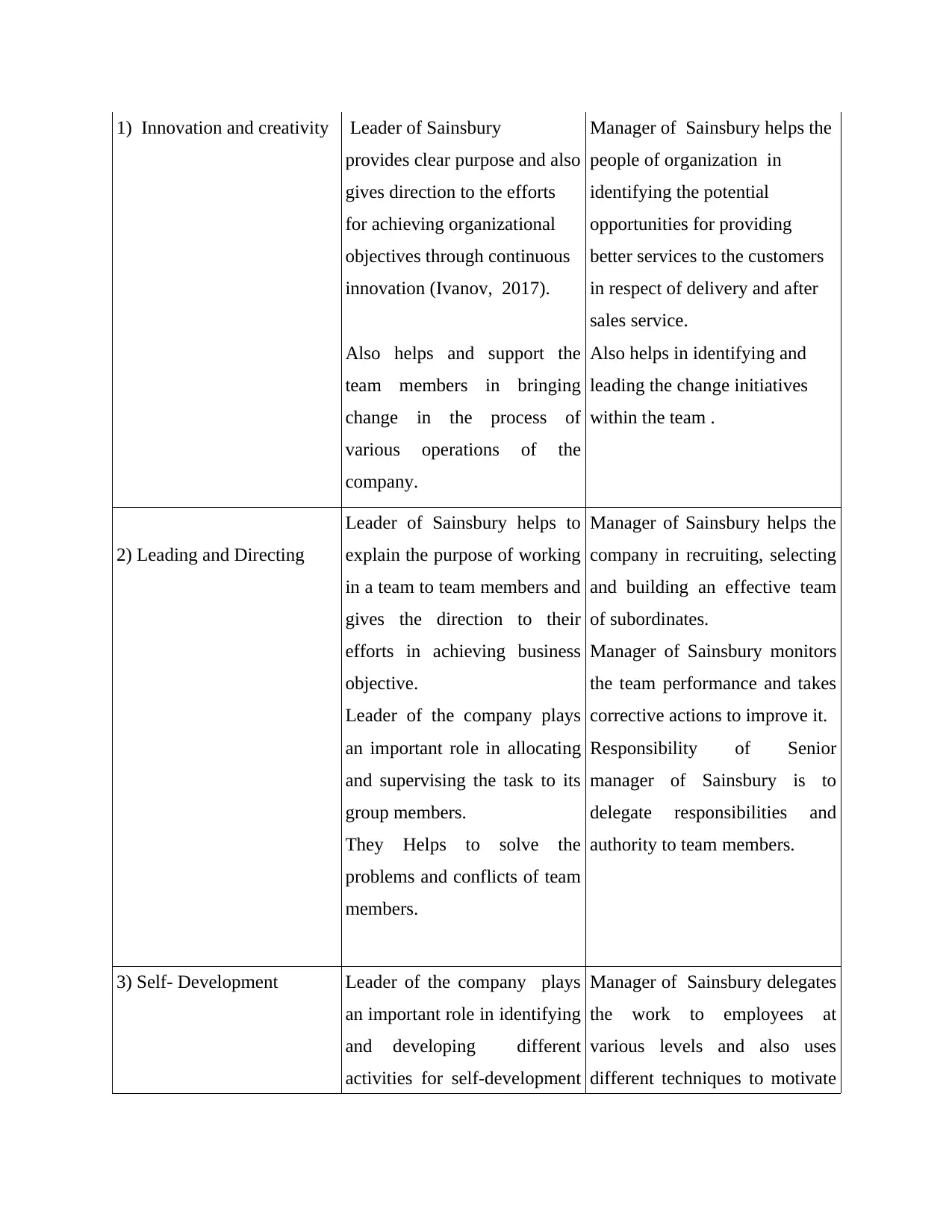
1) Innovation and creativity Leader of Sainsbury
provides clear purpose and also
gives direction to the efforts
for achieving organizational
objectives through continuous
innovation (Ivanov, 2017).
Also helps and support the
team members in bringing
change in the process of
various operations of the
company.
Manager of Sainsbury helps the
people of organization in
identifying the potential
opportunities for providing
better services to the customers
in respect of delivery and after
sales service.
Also helps in identifying and
leading the change initiatives
within the team .
2) Leading and Directing
Leader of Sainsbury helps to
explain the purpose of working
in a team to team members and
gives the direction to their
efforts in achieving business
objective.
Leader of the company plays
an important role in allocating
and supervising the task to its
group members.
They Helps to solve the
problems and conflicts of team
members.
Manager of Sainsbury helps the
company in recruiting, selecting
and building an effective team
of subordinates.
Manager of Sainsbury monitors
the team performance and takes
corrective actions to improve it.
Responsibility of Senior
manager of Sainsbury is to
delegate responsibilities and
authority to team members.
3) Self- Development Leader of the company plays
an important role in identifying
and developing different
activities for self-development
Manager of Sainsbury delegates
the work to employees at
various levels and also uses
different techniques to motivate
provides clear purpose and also
gives direction to the efforts
for achieving organizational
objectives through continuous
innovation (Ivanov, 2017).
Also helps and support the
team members in bringing
change in the process of
various operations of the
company.
Manager of Sainsbury helps the
people of organization in
identifying the potential
opportunities for providing
better services to the customers
in respect of delivery and after
sales service.
Also helps in identifying and
leading the change initiatives
within the team .
2) Leading and Directing
Leader of Sainsbury helps to
explain the purpose of working
in a team to team members and
gives the direction to their
efforts in achieving business
objective.
Leader of the company plays
an important role in allocating
and supervising the task to its
group members.
They Helps to solve the
problems and conflicts of team
members.
Manager of Sainsbury helps the
company in recruiting, selecting
and building an effective team
of subordinates.
Manager of Sainsbury monitors
the team performance and takes
corrective actions to improve it.
Responsibility of Senior
manager of Sainsbury is to
delegate responsibilities and
authority to team members.
3) Self- Development Leader of the company plays
an important role in identifying
and developing different
activities for self-development
Manager of Sainsbury delegates
the work to employees at
various levels and also uses
different techniques to motivate
⊘ This is a preview!⊘
Do you want full access?
Subscribe today to unlock all pages.

Trusted by 1+ million students worldwide
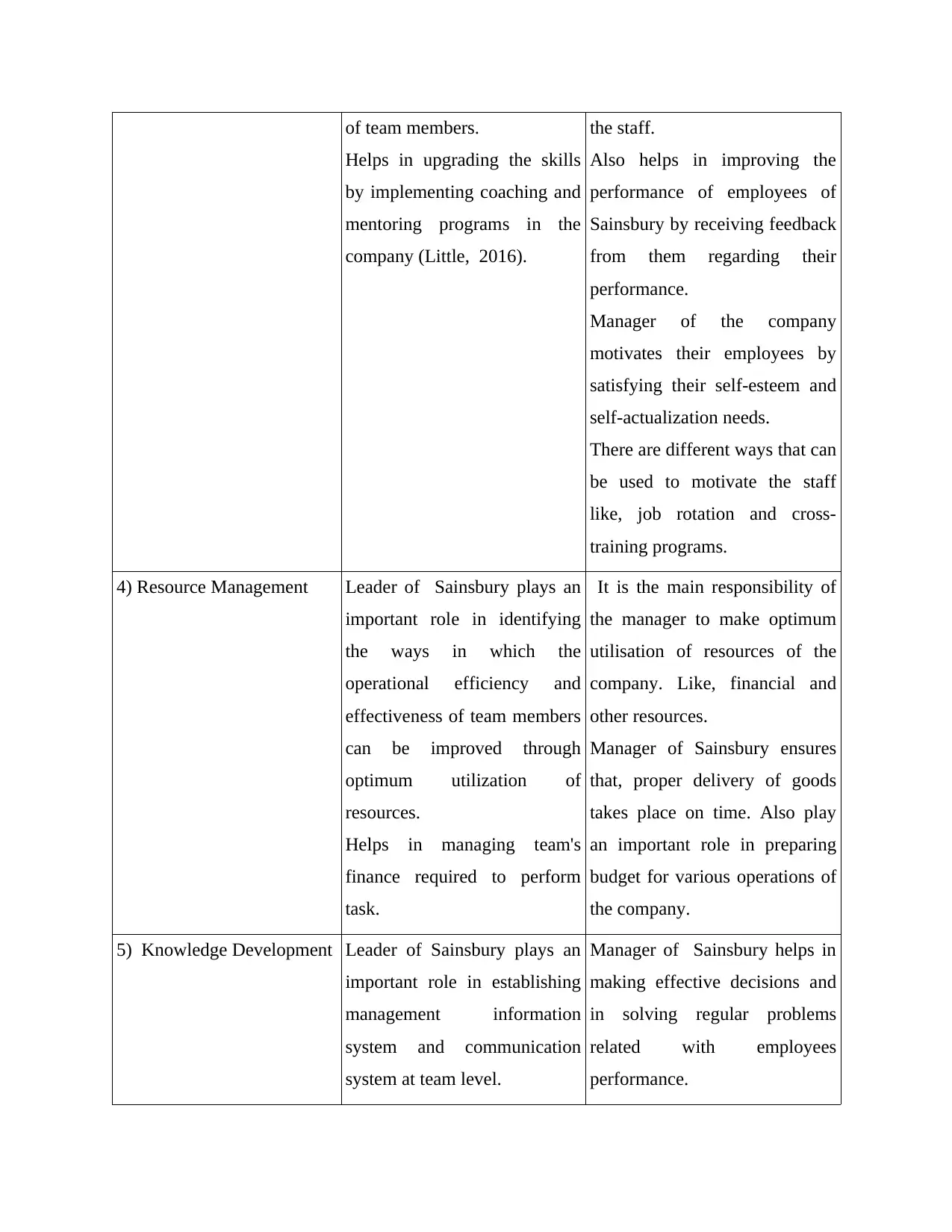
of team members.
Helps in upgrading the skills
by implementing coaching and
mentoring programs in the
company (Little, 2016).
the staff.
Also helps in improving the
performance of employees of
Sainsbury by receiving feedback
from them regarding their
performance.
Manager of the company
motivates their employees by
satisfying their self-esteem and
self-actualization needs.
There are different ways that can
be used to motivate the staff
like, job rotation and cross-
training programs.
4) Resource Management Leader of Sainsbury plays an
important role in identifying
the ways in which the
operational efficiency and
effectiveness of team members
can be improved through
optimum utilization of
resources.
Helps in managing team's
finance required to perform
task.
It is the main responsibility of
the manager to make optimum
utilisation of resources of the
company. Like, financial and
other resources.
Manager of Sainsbury ensures
that, proper delivery of goods
takes place on time. Also play
an important role in preparing
budget for various operations of
the company.
5) Knowledge Development Leader of Sainsbury plays an
important role in establishing
management information
system and communication
system at team level.
Manager of Sainsbury helps in
making effective decisions and
in solving regular problems
related with employees
performance.
Helps in upgrading the skills
by implementing coaching and
mentoring programs in the
company (Little, 2016).
the staff.
Also helps in improving the
performance of employees of
Sainsbury by receiving feedback
from them regarding their
performance.
Manager of the company
motivates their employees by
satisfying their self-esteem and
self-actualization needs.
There are different ways that can
be used to motivate the staff
like, job rotation and cross-
training programs.
4) Resource Management Leader of Sainsbury plays an
important role in identifying
the ways in which the
operational efficiency and
effectiveness of team members
can be improved through
optimum utilization of
resources.
Helps in managing team's
finance required to perform
task.
It is the main responsibility of
the manager to make optimum
utilisation of resources of the
company. Like, financial and
other resources.
Manager of Sainsbury ensures
that, proper delivery of goods
takes place on time. Also play
an important role in preparing
budget for various operations of
the company.
5) Knowledge Development Leader of Sainsbury plays an
important role in establishing
management information
system and communication
system at team level.
Manager of Sainsbury helps in
making effective decisions and
in solving regular problems
related with employees
performance.
Paraphrase This Document
Need a fresh take? Get an instant paraphrase of this document with our AI Paraphraser
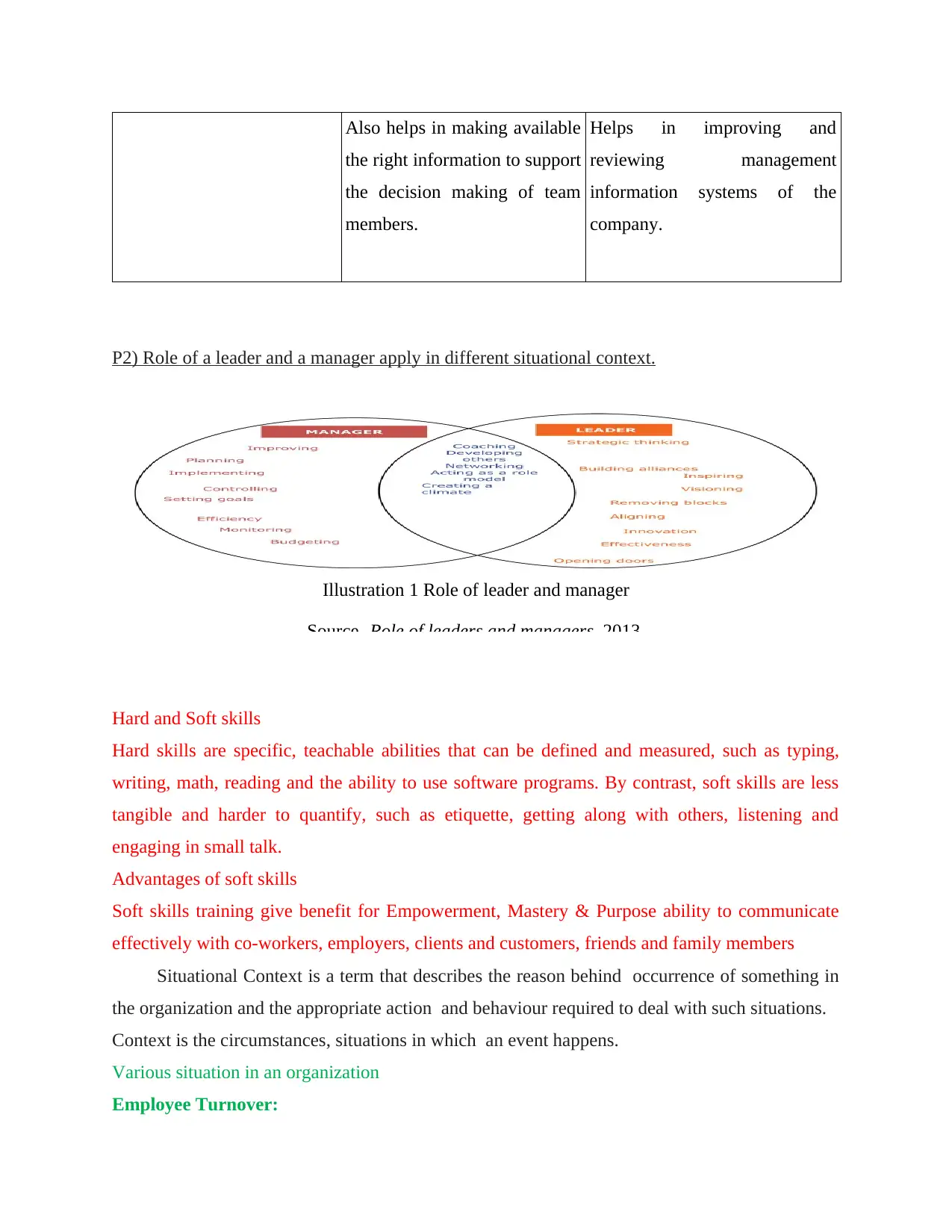
Also helps in making available
the right information to support
the decision making of team
members.
Helps in improving and
reviewing management
information systems of the
company.
P2) Role of a leader and a manager apply in different situational context.
Hard and Soft skills
Hard skills are specific, teachable abilities that can be defined and measured, such as typing,
writing, math, reading and the ability to use software programs. By contrast, soft skills are less
tangible and harder to quantify, such as etiquette, getting along with others, listening and
engaging in small talk.
Advantages of soft skills
Soft skills training give benefit for Empowerment, Mastery & Purpose ability to communicate
effectively with co-workers, employers, clients and customers, friends and family members
Situational Context is a term that describes the reason behind occurrence of something in
the organization and the appropriate action and behaviour required to deal with such situations.
Context is the circumstances, situations in which an event happens.
Various situation in an organization
Employee Turnover:
Illustration 1 Role of leader and manager
Source- Role of leaders and managers, 2013.
the right information to support
the decision making of team
members.
Helps in improving and
reviewing management
information systems of the
company.
P2) Role of a leader and a manager apply in different situational context.
Hard and Soft skills
Hard skills are specific, teachable abilities that can be defined and measured, such as typing,
writing, math, reading and the ability to use software programs. By contrast, soft skills are less
tangible and harder to quantify, such as etiquette, getting along with others, listening and
engaging in small talk.
Advantages of soft skills
Soft skills training give benefit for Empowerment, Mastery & Purpose ability to communicate
effectively with co-workers, employers, clients and customers, friends and family members
Situational Context is a term that describes the reason behind occurrence of something in
the organization and the appropriate action and behaviour required to deal with such situations.
Context is the circumstances, situations in which an event happens.
Various situation in an organization
Employee Turnover:
Illustration 1 Role of leader and manager
Source- Role of leaders and managers, 2013.
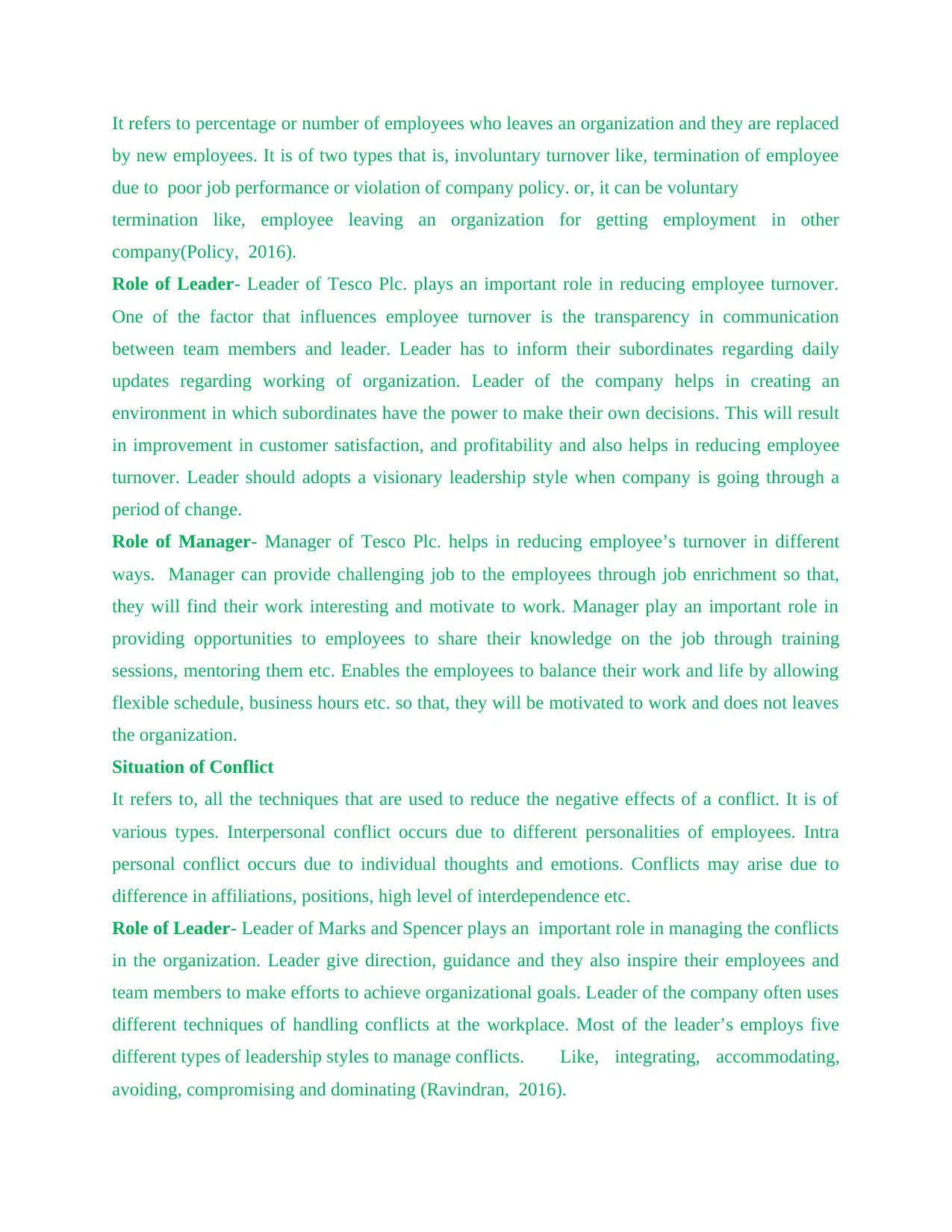
It refers to percentage or number of employees who leaves an organization and they are replaced
by new employees. It is of two types that is, involuntary turnover like, termination of employee
due to poor job performance or violation of company policy. or, it can be voluntary
termination like, employee leaving an organization for getting employment in other
company(Policy, 2016).
Role of Leader- Leader of Tesco Plc. plays an important role in reducing employee turnover.
One of the factor that influences employee turnover is the transparency in communication
between team members and leader. Leader has to inform their subordinates regarding daily
updates regarding working of organization. Leader of the company helps in creating an
environment in which subordinates have the power to make their own decisions. This will result
in improvement in customer satisfaction, and profitability and also helps in reducing employee
turnover. Leader should adopts a visionary leadership style when company is going through a
period of change.
Role of Manager- Manager of Tesco Plc. helps in reducing employee’s turnover in different
ways. Manager can provide challenging job to the employees through job enrichment so that,
they will find their work interesting and motivate to work. Manager play an important role in
providing opportunities to employees to share their knowledge on the job through training
sessions, mentoring them etc. Enables the employees to balance their work and life by allowing
flexible schedule, business hours etc. so that, they will be motivated to work and does not leaves
the organization.
Situation of Conflict
It refers to, all the techniques that are used to reduce the negative effects of a conflict. It is of
various types. Interpersonal conflict occurs due to different personalities of employees. Intra
personal conflict occurs due to individual thoughts and emotions. Conflicts may arise due to
difference in affiliations, positions, high level of interdependence etc.
Role of Leader- Leader of Marks and Spencer plays an important role in managing the conflicts
in the organization. Leader give direction, guidance and they also inspire their employees and
team members to make efforts to achieve organizational goals. Leader of the company often uses
different techniques of handling conflicts at the workplace. Most of the leader’s employs five
different types of leadership styles to manage conflicts. Like, integrating, accommodating,
avoiding, compromising and dominating (Ravindran, 2016).
by new employees. It is of two types that is, involuntary turnover like, termination of employee
due to poor job performance or violation of company policy. or, it can be voluntary
termination like, employee leaving an organization for getting employment in other
company(Policy, 2016).
Role of Leader- Leader of Tesco Plc. plays an important role in reducing employee turnover.
One of the factor that influences employee turnover is the transparency in communication
between team members and leader. Leader has to inform their subordinates regarding daily
updates regarding working of organization. Leader of the company helps in creating an
environment in which subordinates have the power to make their own decisions. This will result
in improvement in customer satisfaction, and profitability and also helps in reducing employee
turnover. Leader should adopts a visionary leadership style when company is going through a
period of change.
Role of Manager- Manager of Tesco Plc. helps in reducing employee’s turnover in different
ways. Manager can provide challenging job to the employees through job enrichment so that,
they will find their work interesting and motivate to work. Manager play an important role in
providing opportunities to employees to share their knowledge on the job through training
sessions, mentoring them etc. Enables the employees to balance their work and life by allowing
flexible schedule, business hours etc. so that, they will be motivated to work and does not leaves
the organization.
Situation of Conflict
It refers to, all the techniques that are used to reduce the negative effects of a conflict. It is of
various types. Interpersonal conflict occurs due to different personalities of employees. Intra
personal conflict occurs due to individual thoughts and emotions. Conflicts may arise due to
difference in affiliations, positions, high level of interdependence etc.
Role of Leader- Leader of Marks and Spencer plays an important role in managing the conflicts
in the organization. Leader give direction, guidance and they also inspire their employees and
team members to make efforts to achieve organizational goals. Leader of the company often uses
different techniques of handling conflicts at the workplace. Most of the leader’s employs five
different types of leadership styles to manage conflicts. Like, integrating, accommodating,
avoiding, compromising and dominating (Ravindran, 2016).
⊘ This is a preview!⊘
Do you want full access?
Subscribe today to unlock all pages.

Trusted by 1+ million students worldwide
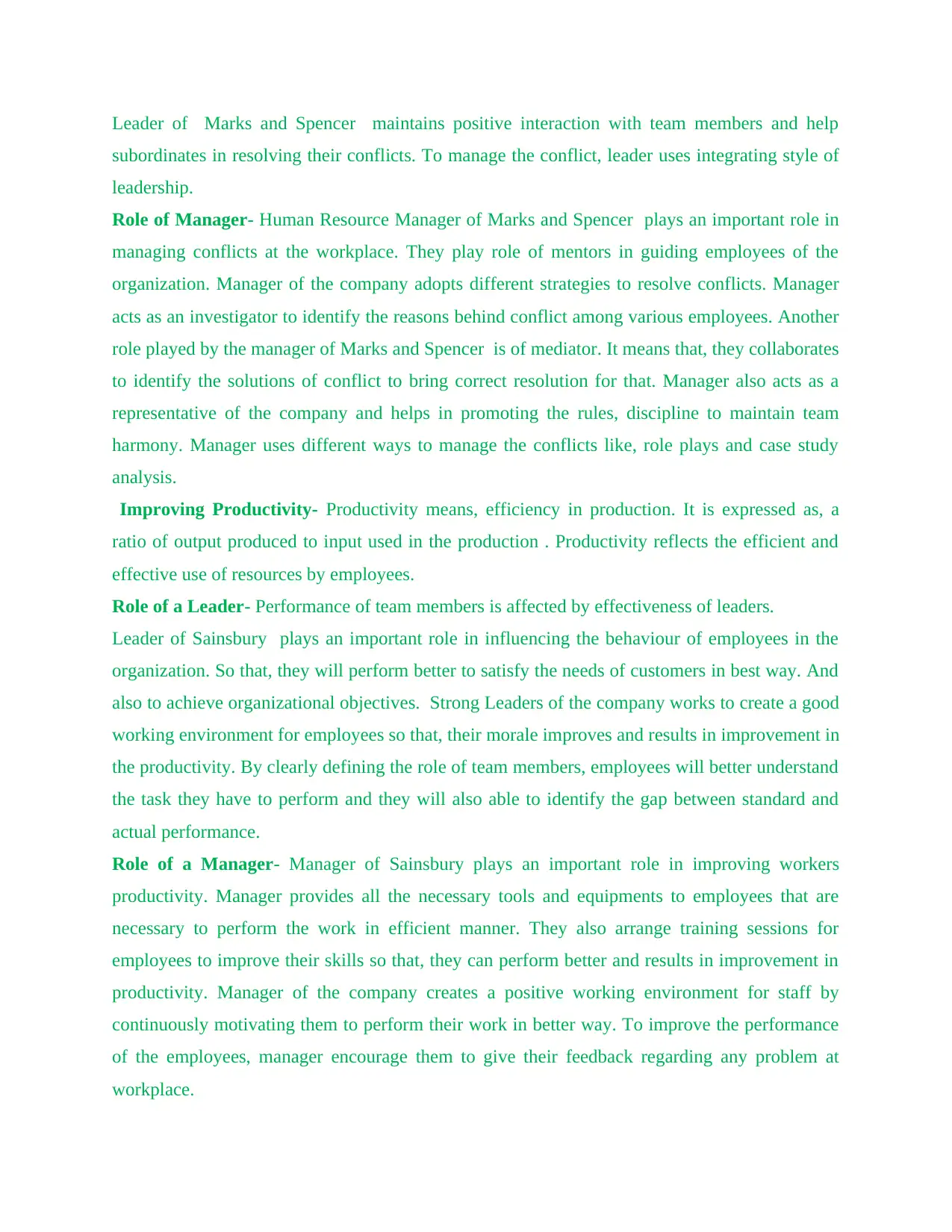
Leader of Marks and Spencer maintains positive interaction with team members and help
subordinates in resolving their conflicts. To manage the conflict, leader uses integrating style of
leadership.
Role of Manager- Human Resource Manager of Marks and Spencer plays an important role in
managing conflicts at the workplace. They play role of mentors in guiding employees of the
organization. Manager of the company adopts different strategies to resolve conflicts. Manager
acts as an investigator to identify the reasons behind conflict among various employees. Another
role played by the manager of Marks and Spencer is of mediator. It means that, they collaborates
to identify the solutions of conflict to bring correct resolution for that. Manager also acts as a
representative of the company and helps in promoting the rules, discipline to maintain team
harmony. Manager uses different ways to manage the conflicts like, role plays and case study
analysis.
Improving Productivity- Productivity means, efficiency in production. It is expressed as, a
ratio of output produced to input used in the production . Productivity reflects the efficient and
effective use of resources by employees.
Role of a Leader- Performance of team members is affected by effectiveness of leaders.
Leader of Sainsbury plays an important role in influencing the behaviour of employees in the
organization. So that, they will perform better to satisfy the needs of customers in best way. And
also to achieve organizational objectives. Strong Leaders of the company works to create a good
working environment for employees so that, their morale improves and results in improvement in
the productivity. By clearly defining the role of team members, employees will better understand
the task they have to perform and they will also able to identify the gap between standard and
actual performance.
Role of a Manager- Manager of Sainsbury plays an important role in improving workers
productivity. Manager provides all the necessary tools and equipments to employees that are
necessary to perform the work in efficient manner. They also arrange training sessions for
employees to improve their skills so that, they can perform better and results in improvement in
productivity. Manager of the company creates a positive working environment for staff by
continuously motivating them to perform their work in better way. To improve the performance
of the employees, manager encourage them to give their feedback regarding any problem at
workplace.
subordinates in resolving their conflicts. To manage the conflict, leader uses integrating style of
leadership.
Role of Manager- Human Resource Manager of Marks and Spencer plays an important role in
managing conflicts at the workplace. They play role of mentors in guiding employees of the
organization. Manager of the company adopts different strategies to resolve conflicts. Manager
acts as an investigator to identify the reasons behind conflict among various employees. Another
role played by the manager of Marks and Spencer is of mediator. It means that, they collaborates
to identify the solutions of conflict to bring correct resolution for that. Manager also acts as a
representative of the company and helps in promoting the rules, discipline to maintain team
harmony. Manager uses different ways to manage the conflicts like, role plays and case study
analysis.
Improving Productivity- Productivity means, efficiency in production. It is expressed as, a
ratio of output produced to input used in the production . Productivity reflects the efficient and
effective use of resources by employees.
Role of a Leader- Performance of team members is affected by effectiveness of leaders.
Leader of Sainsbury plays an important role in influencing the behaviour of employees in the
organization. So that, they will perform better to satisfy the needs of customers in best way. And
also to achieve organizational objectives. Strong Leaders of the company works to create a good
working environment for employees so that, their morale improves and results in improvement in
the productivity. By clearly defining the role of team members, employees will better understand
the task they have to perform and they will also able to identify the gap between standard and
actual performance.
Role of a Manager- Manager of Sainsbury plays an important role in improving workers
productivity. Manager provides all the necessary tools and equipments to employees that are
necessary to perform the work in efficient manner. They also arrange training sessions for
employees to improve their skills so that, they can perform better and results in improvement in
productivity. Manager of the company creates a positive working environment for staff by
continuously motivating them to perform their work in better way. To improve the performance
of the employees, manager encourage them to give their feedback regarding any problem at
workplace.
Paraphrase This Document
Need a fresh take? Get an instant paraphrase of this document with our AI Paraphraser
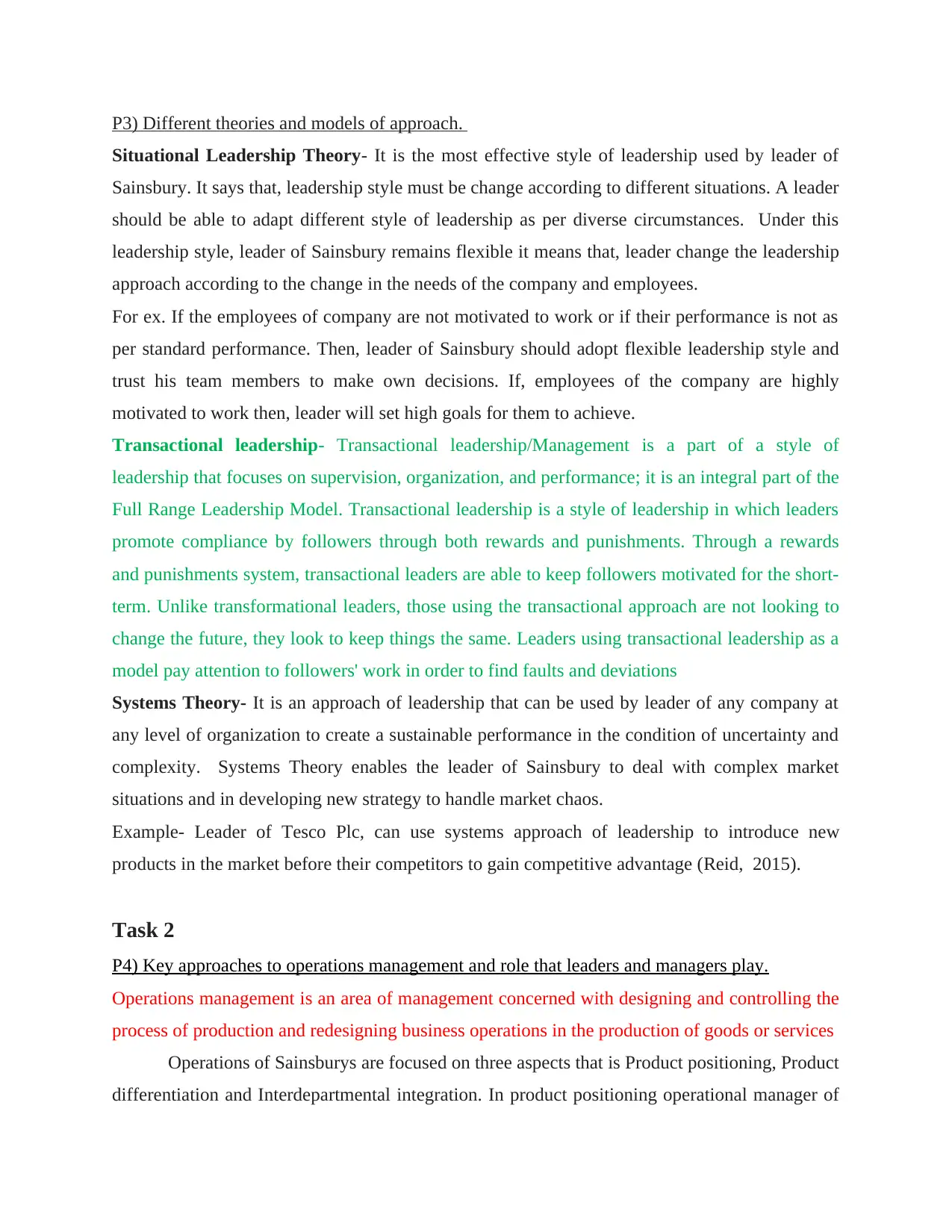
P3) Different theories and models of approach.
Situational Leadership Theory- It is the most effective style of leadership used by leader of
Sainsbury. It says that, leadership style must be change according to different situations. A leader
should be able to adapt different style of leadership as per diverse circumstances. Under this
leadership style, leader of Sainsbury remains flexible it means that, leader change the leadership
approach according to the change in the needs of the company and employees.
For ex. If the employees of company are not motivated to work or if their performance is not as
per standard performance. Then, leader of Sainsbury should adopt flexible leadership style and
trust his team members to make own decisions. If, employees of the company are highly
motivated to work then, leader will set high goals for them to achieve.
Transactional leadership- Transactional leadership/Management is a part of a style of
leadership that focuses on supervision, organization, and performance; it is an integral part of the
Full Range Leadership Model. Transactional leadership is a style of leadership in which leaders
promote compliance by followers through both rewards and punishments. Through a rewards
and punishments system, transactional leaders are able to keep followers motivated for the short-
term. Unlike transformational leaders, those using the transactional approach are not looking to
change the future, they look to keep things the same. Leaders using transactional leadership as a
model pay attention to followers' work in order to find faults and deviations
Systems Theory- It is an approach of leadership that can be used by leader of any company at
any level of organization to create a sustainable performance in the condition of uncertainty and
complexity. Systems Theory enables the leader of Sainsbury to deal with complex market
situations and in developing new strategy to handle market chaos.
Example- Leader of Tesco Plc, can use systems approach of leadership to introduce new
products in the market before their competitors to gain competitive advantage (Reid, 2015).
Task 2
P4) Key approaches to operations management and role that leaders and managers play.
Operations management is an area of management concerned with designing and controlling the
process of production and redesigning business operations in the production of goods or services
Operations of Sainsburys are focused on three aspects that is Product positioning, Product
differentiation and Interdepartmental integration. In product positioning operational manager of
Situational Leadership Theory- It is the most effective style of leadership used by leader of
Sainsbury. It says that, leadership style must be change according to different situations. A leader
should be able to adapt different style of leadership as per diverse circumstances. Under this
leadership style, leader of Sainsbury remains flexible it means that, leader change the leadership
approach according to the change in the needs of the company and employees.
For ex. If the employees of company are not motivated to work or if their performance is not as
per standard performance. Then, leader of Sainsbury should adopt flexible leadership style and
trust his team members to make own decisions. If, employees of the company are highly
motivated to work then, leader will set high goals for them to achieve.
Transactional leadership- Transactional leadership/Management is a part of a style of
leadership that focuses on supervision, organization, and performance; it is an integral part of the
Full Range Leadership Model. Transactional leadership is a style of leadership in which leaders
promote compliance by followers through both rewards and punishments. Through a rewards
and punishments system, transactional leaders are able to keep followers motivated for the short-
term. Unlike transformational leaders, those using the transactional approach are not looking to
change the future, they look to keep things the same. Leaders using transactional leadership as a
model pay attention to followers' work in order to find faults and deviations
Systems Theory- It is an approach of leadership that can be used by leader of any company at
any level of organization to create a sustainable performance in the condition of uncertainty and
complexity. Systems Theory enables the leader of Sainsbury to deal with complex market
situations and in developing new strategy to handle market chaos.
Example- Leader of Tesco Plc, can use systems approach of leadership to introduce new
products in the market before their competitors to gain competitive advantage (Reid, 2015).
Task 2
P4) Key approaches to operations management and role that leaders and managers play.
Operations management is an area of management concerned with designing and controlling the
process of production and redesigning business operations in the production of goods or services
Operations of Sainsburys are focused on three aspects that is Product positioning, Product
differentiation and Interdepartmental integration. In product positioning operational manager of
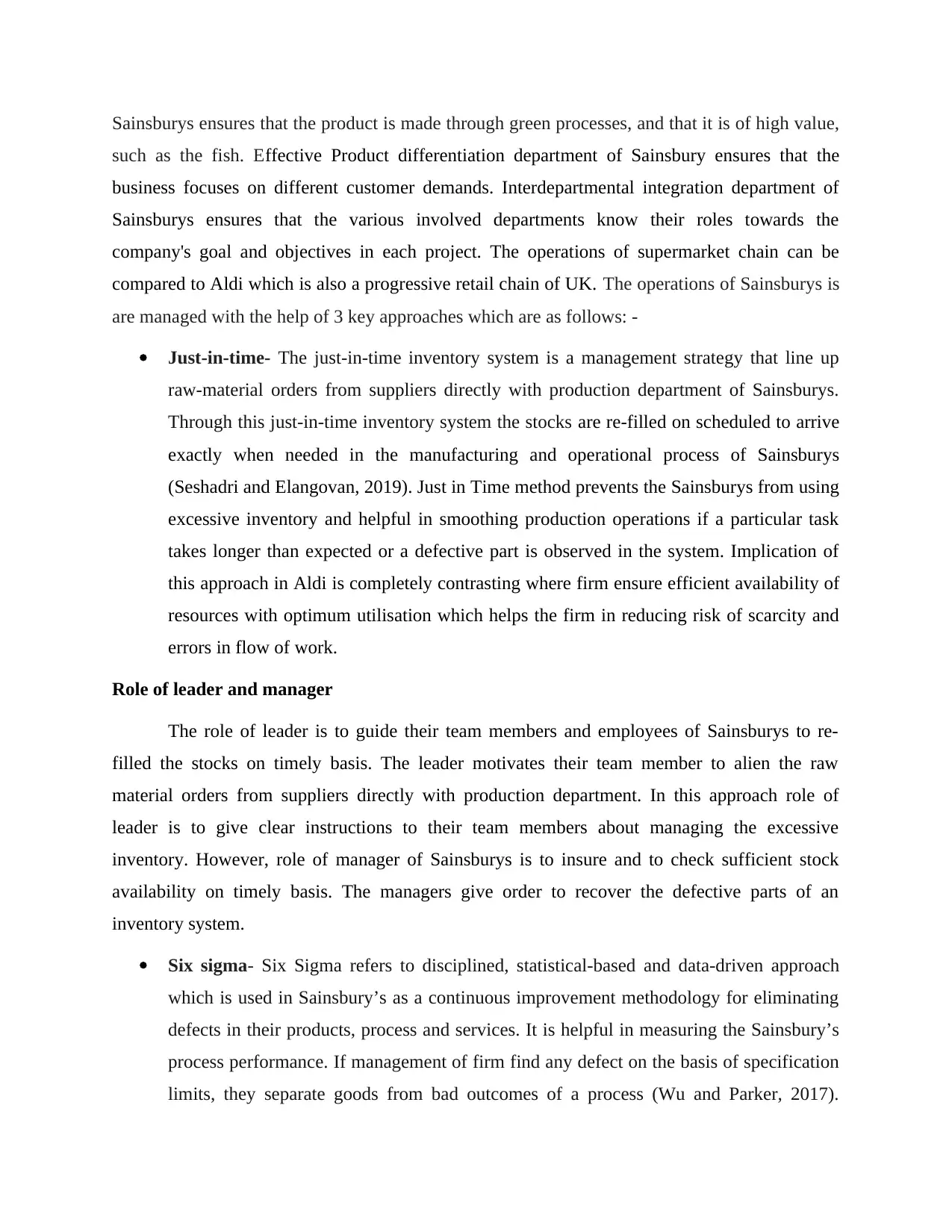
Sainsburys ensures that the product is made through green processes, and that it is of high value,
such as the fish. Effective Product differentiation department of Sainsbury ensures that the
business focuses on different customer demands. Interdepartmental integration department of
Sainsburys ensures that the various involved departments know their roles towards the
company's goal and objectives in each project. The operations of supermarket chain can be
compared to Aldi which is also a progressive retail chain of UK. The operations of Sainsburys is
are managed with the help of 3 key approaches which are as follows: -
Just-in-time- The just-in-time inventory system is a management strategy that line up
raw-material orders from suppliers directly with production department of Sainsburys.
Through this just-in-time inventory system the stocks are re-filled on scheduled to arrive
exactly when needed in the manufacturing and operational process of Sainsburys
(Seshadri and Elangovan, 2019). Just in Time method prevents the Sainsburys from using
excessive inventory and helpful in smoothing production operations if a particular task
takes longer than expected or a defective part is observed in the system. Implication of
this approach in Aldi is completely contrasting where firm ensure efficient availability of
resources with optimum utilisation which helps the firm in reducing risk of scarcity and
errors in flow of work.
Role of leader and manager
The role of leader is to guide their team members and employees of Sainsburys to re-
filled the stocks on timely basis. The leader motivates their team member to alien the raw
material orders from suppliers directly with production department. In this approach role of
leader is to give clear instructions to their team members about managing the excessive
inventory. However, role of manager of Sainsburys is to insure and to check sufficient stock
availability on timely basis. The managers give order to recover the defective parts of an
inventory system.
Six sigma- Six Sigma refers to disciplined, statistical-based and data-driven approach
which is used in Sainsbury’s as a continuous improvement methodology for eliminating
defects in their products, process and services. It is helpful in measuring the Sainsbury’s
process performance. If management of firm find any defect on the basis of specification
limits, they separate goods from bad outcomes of a process (Wu and Parker, 2017).
such as the fish. Effective Product differentiation department of Sainsbury ensures that the
business focuses on different customer demands. Interdepartmental integration department of
Sainsburys ensures that the various involved departments know their roles towards the
company's goal and objectives in each project. The operations of supermarket chain can be
compared to Aldi which is also a progressive retail chain of UK. The operations of Sainsburys is
are managed with the help of 3 key approaches which are as follows: -
Just-in-time- The just-in-time inventory system is a management strategy that line up
raw-material orders from suppliers directly with production department of Sainsburys.
Through this just-in-time inventory system the stocks are re-filled on scheduled to arrive
exactly when needed in the manufacturing and operational process of Sainsburys
(Seshadri and Elangovan, 2019). Just in Time method prevents the Sainsburys from using
excessive inventory and helpful in smoothing production operations if a particular task
takes longer than expected or a defective part is observed in the system. Implication of
this approach in Aldi is completely contrasting where firm ensure efficient availability of
resources with optimum utilisation which helps the firm in reducing risk of scarcity and
errors in flow of work.
Role of leader and manager
The role of leader is to guide their team members and employees of Sainsburys to re-
filled the stocks on timely basis. The leader motivates their team member to alien the raw
material orders from suppliers directly with production department. In this approach role of
leader is to give clear instructions to their team members about managing the excessive
inventory. However, role of manager of Sainsburys is to insure and to check sufficient stock
availability on timely basis. The managers give order to recover the defective parts of an
inventory system.
Six sigma- Six Sigma refers to disciplined, statistical-based and data-driven approach
which is used in Sainsbury’s as a continuous improvement methodology for eliminating
defects in their products, process and services. It is helpful in measuring the Sainsbury’s
process performance. If management of firm find any defect on the basis of specification
limits, they separate goods from bad outcomes of a process (Wu and Parker, 2017).
⊘ This is a preview!⊘
Do you want full access?
Subscribe today to unlock all pages.

Trusted by 1+ million students worldwide
1 out of 20
Related Documents
Your All-in-One AI-Powered Toolkit for Academic Success.
+13062052269
info@desklib.com
Available 24*7 on WhatsApp / Email
![[object Object]](/_next/static/media/star-bottom.7253800d.svg)
Unlock your academic potential
Copyright © 2020–2025 A2Z Services. All Rights Reserved. Developed and managed by ZUCOL.




